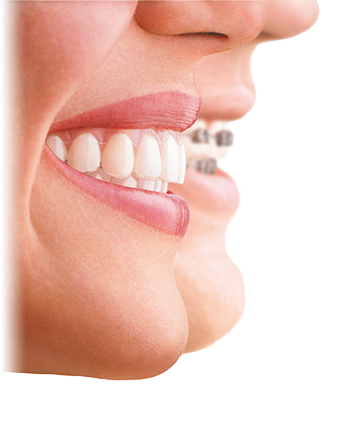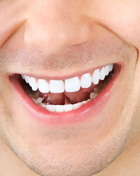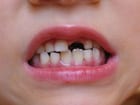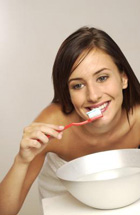 If you are resigned to the fact that you have to wear a brace, chances are you’re thinking of the more traditional methods where you are subjected to up to 3 years of hell. Well you should think again, says a dentist from the city of Leeds. The field of orthodontics deals with maintaining the correct alignment to occlusion or the bite of the jaw. To do this can involve the fitting of braces. But with the advances in technology and modern dentist procedures, this doesn’t have to be a long drawn out process anymore, thanks to three revolutionary techniques. The Inman aligner is aimed primarily at the front teeth of adults. A coil spring exerts pressure on the teeth, whilst a bar behind reverses that pressure. The result is that the teeth are gently pushed and pulled into position and the process can be over in as little as 6 weeks. This is also a lot cheaper than other techniques. The Damon brace uses a self-ligating wire to allow the brace to move with the teeth. It appears discreet in the mouth and is easy to clean and quicker than conventional braces. The most expensive option is the Invasalign. An ‘invisible’ retainer is fitted to the teeth and can carry out full adjustment of the teeth in a minimum of 12 months. It has to be changed every month, but its main advantage is that it can be removed during eating and when cleaning the teeth.
If you are resigned to the fact that you have to wear a brace, chances are you’re thinking of the more traditional methods where you are subjected to up to 3 years of hell. Well you should think again, says a dentist from the city of Leeds. The field of orthodontics deals with maintaining the correct alignment to occlusion or the bite of the jaw. To do this can involve the fitting of braces. But with the advances in technology and modern dentist procedures, this doesn’t have to be a long drawn out process anymore, thanks to three revolutionary techniques. The Inman aligner is aimed primarily at the front teeth of adults. A coil spring exerts pressure on the teeth, whilst a bar behind reverses that pressure. The result is that the teeth are gently pushed and pulled into position and the process can be over in as little as 6 weeks. This is also a lot cheaper than other techniques. The Damon brace uses a self-ligating wire to allow the brace to move with the teeth. It appears discreet in the mouth and is easy to clean and quicker than conventional braces. The most expensive option is the Invasalign. An ‘invisible’ retainer is fitted to the teeth and can carry out full adjustment of the teeth in a minimum of 12 months. It has to be changed every month, but its main advantage is that it can be removed during eating and when cleaning the teeth.





 Implants have come a very long way since they first hit the scene way back in Sweden. Computers have revolutionised implant designs and methods and will continue to do so in the future, according to a dentist in central Leeds. The principles of implants still remain. A hole is drill into the jaw and the new ‘root’ screwed in. Once the healing process is complete, the new bridge or crown can be attached. But the methods by which all these processes are carried out have progressed tremendously. There are three radical advances in screw to bone techniques. The bio-horizons’ implant technology, the ankylos implant system and the syncone system. All of these methods are tailored to what’s best for each individual patient. Some people may need a ‘little less of that and bit more of this’ to define the precise treatment required and each of these techniques, with the use of computer programs and analysis scanners, use state of the art surgery techniques to achieve their goals- piezo surgery is one of these techniques. It centres on cutting the bone and leaving the gum intact, reducing damage to nerve tissue, healing time and the risk of infection. Healing processes have advanced too. Plasma rich growth factor uses a combination of proteins that stimulate and house new bone synthesis and regenerate soft tissue. With such attention to detail and advancement in technology, having implants fitted can be better than the real thing!
Implants have come a very long way since they first hit the scene way back in Sweden. Computers have revolutionised implant designs and methods and will continue to do so in the future, according to a dentist in central Leeds. The principles of implants still remain. A hole is drill into the jaw and the new ‘root’ screwed in. Once the healing process is complete, the new bridge or crown can be attached. But the methods by which all these processes are carried out have progressed tremendously. There are three radical advances in screw to bone techniques. The bio-horizons’ implant technology, the ankylos implant system and the syncone system. All of these methods are tailored to what’s best for each individual patient. Some people may need a ‘little less of that and bit more of this’ to define the precise treatment required and each of these techniques, with the use of computer programs and analysis scanners, use state of the art surgery techniques to achieve their goals- piezo surgery is one of these techniques. It centres on cutting the bone and leaving the gum intact, reducing damage to nerve tissue, healing time and the risk of infection. Healing processes have advanced too. Plasma rich growth factor uses a combination of proteins that stimulate and house new bone synthesis and regenerate soft tissue. With such attention to detail and advancement in technology, having implants fitted can be better than the real thing! When is a hopeless tooth considered to be a hopeless? You would have thought the answer would be obvious. It’s in the title- hopeless. But as any dentist in Leeds will tell you, it isn’t that easy a decision to make. 50 years ago, the decision to remove a tooth was a lot easier. Now however, with modern techniques and treatments, a dentist would rather pull out all the stops, than pull out the tooth. Generally, there are two major factors to consider before rendering a tooth a lost cause- restorability and periodontal support. Modern advances in treatments make most teeth restorable. Most endodontic techniques can restore a damaged or decayed tooth. By using root canal treatment, the affected tooth can be can be saved by the removal of the roots, dead tissue and nerves and then having the hole cleaned and filled, before deciding whether to cap the tooth. This will restore function. But what runs deeper at this point is just how much damage has been caused to the surrounding area by the damage or the decay to the tooth. Periodontic diagnosis of the area around the tooth relies on how advanced the disease has become. It will rely on the pocket depth between the tooth and gum, the decay in the bone supporting the tooth, the level of mobility in the tooth and the crown to root ratio. And before rendering the tooth hopeless, there are two final factors to consider before the tooth is condemned. The rate of progression of periodontal disease and the age of the patient- the older the patient, the more likely the tooth will be removed.
When is a hopeless tooth considered to be a hopeless? You would have thought the answer would be obvious. It’s in the title- hopeless. But as any dentist in Leeds will tell you, it isn’t that easy a decision to make. 50 years ago, the decision to remove a tooth was a lot easier. Now however, with modern techniques and treatments, a dentist would rather pull out all the stops, than pull out the tooth. Generally, there are two major factors to consider before rendering a tooth a lost cause- restorability and periodontal support. Modern advances in treatments make most teeth restorable. Most endodontic techniques can restore a damaged or decayed tooth. By using root canal treatment, the affected tooth can be can be saved by the removal of the roots, dead tissue and nerves and then having the hole cleaned and filled, before deciding whether to cap the tooth. This will restore function. But what runs deeper at this point is just how much damage has been caused to the surrounding area by the damage or the decay to the tooth. Periodontic diagnosis of the area around the tooth relies on how advanced the disease has become. It will rely on the pocket depth between the tooth and gum, the decay in the bone supporting the tooth, the level of mobility in the tooth and the crown to root ratio. And before rendering the tooth hopeless, there are two final factors to consider before the tooth is condemned. The rate of progression of periodontal disease and the age of the patient- the older the patient, the more likely the tooth will be removed. If you happen to get canker sores, you will know the pain and irritation they can cause, but where they come from and what causes them is still a bit of a mystery, claims a dentist in central Leeds. They tend to erupt inside the mouth- on the inside of the lips, gums and on the tongue and can be confused with toothache. Although not contagious, it is widely agreed that they are handed down in the family through generations and are more common in women. There are three main types of canker sores. The most common is the minor sore, which is small and lasts for around 8 days. The major sore is a lot larger and more painful and can hang around in the mouth for almost a month. Herpetiform ulcers appear in clusters and they also last around 8 days. They start as a gentle swelling but erupt quickly and because they are difficult to treat, they can cause great discomfort until they disappear. Though the causes of these sores are a bit of a grey area, they can be linked to the same reasons why other problems affect the mouth- vitamin deficiency, poor diet, stress, poor dental hygiene, a weak immune system, hormone imbalance (as in pregnancy), smoking and drinking. Treating them is also a grey area, there are canker related medications that tend to soothe rather than cure. As with cold sores, they seemingly come and go at there own leisure, but a dentist will be able to offer advice on treating them.
If you happen to get canker sores, you will know the pain and irritation they can cause, but where they come from and what causes them is still a bit of a mystery, claims a dentist in central Leeds. They tend to erupt inside the mouth- on the inside of the lips, gums and on the tongue and can be confused with toothache. Although not contagious, it is widely agreed that they are handed down in the family through generations and are more common in women. There are three main types of canker sores. The most common is the minor sore, which is small and lasts for around 8 days. The major sore is a lot larger and more painful and can hang around in the mouth for almost a month. Herpetiform ulcers appear in clusters and they also last around 8 days. They start as a gentle swelling but erupt quickly and because they are difficult to treat, they can cause great discomfort until they disappear. Though the causes of these sores are a bit of a grey area, they can be linked to the same reasons why other problems affect the mouth- vitamin deficiency, poor diet, stress, poor dental hygiene, a weak immune system, hormone imbalance (as in pregnancy), smoking and drinking. Treating them is also a grey area, there are canker related medications that tend to soothe rather than cure. As with cold sores, they seemingly come and go at there own leisure, but a dentist will be able to offer advice on treating them. For some reason, the evil legend that is the root canal still tends to strike fear into its prey and once the victim has had the excruciating treatment, pain ensues for months. Sound familiar- well it does to most dentists in the city of Leeds! In all reality, a simple look on the internet could dispel any myths that surround the procedure. The reason for having a root canal stems from bad oral hygiene, allowing plaque to develop and form cavities. If the tooth is to be saved, then the cavity must be cleared of decay, the roots removed and the gap that’s left filled. In times gone by, the tooth would have been ‘pulled’ and here lies one of the myths that surround root canals. If a tooth is causing pain, an extraction is not only considered to be less painful, but cheaper too (the truth is, a root canal is no more painful than a filling). But removing a tooth (when it needn’t be) leads to all sorts of problems. The surrounding teeth can suffer trauma, start to move and become loose, leading to gum disease and infection. Another myth that stems out of this treatment is based on other people’s experiences, like that of your parent’s in the bad old days, “my god! This is what I’m in for!” If in this modern world, you still listen to gossip, believe in fairies, monsters and death by root canal, maybe a little research and a consultation with your dentist will dispel such myths, allowing you to sleep at night with the light out and get out more.
For some reason, the evil legend that is the root canal still tends to strike fear into its prey and once the victim has had the excruciating treatment, pain ensues for months. Sound familiar- well it does to most dentists in the city of Leeds! In all reality, a simple look on the internet could dispel any myths that surround the procedure. The reason for having a root canal stems from bad oral hygiene, allowing plaque to develop and form cavities. If the tooth is to be saved, then the cavity must be cleared of decay, the roots removed and the gap that’s left filled. In times gone by, the tooth would have been ‘pulled’ and here lies one of the myths that surround root canals. If a tooth is causing pain, an extraction is not only considered to be less painful, but cheaper too (the truth is, a root canal is no more painful than a filling). But removing a tooth (when it needn’t be) leads to all sorts of problems. The surrounding teeth can suffer trauma, start to move and become loose, leading to gum disease and infection. Another myth that stems out of this treatment is based on other people’s experiences, like that of your parent’s in the bad old days, “my god! This is what I’m in for!” If in this modern world, you still listen to gossip, believe in fairies, monsters and death by root canal, maybe a little research and a consultation with your dentist will dispel such myths, allowing you to sleep at night with the light out and get out more. Unless you are planning on a lifetime role as a witch in Macbeth, decaying teeth are not only unsightly, but they can give rise to serious health problems, according to a dentist from central Leeds. Children are prone to tooth decay, as teeth grow and new ones come through and where plaque is allowed to form. The problems usually start with bad oral hygiene- the lack of brushing, bad diet, smoking and heavy drinking, which is why a bi-annual visit to the dentist is important in countering any signs of decay. Plaque is the catalyst for tooth decay. This can be removed by brushing and flossing, but if allowed to build up, it will turn to tartar, from which cavities or caries start to form. It doesn’t happen overnight; it can take months, even years for the problem to arise, but when it does, it has a knock-on affect. Infection can set in leading to gum disease, periodontivis and eventually, tooth loss. Spotting it early on is important and an x-ray or radiograph will pick up any signs of a cavity forming. Depending how advanced the problem is, treatment will be required immediately to remove any decay from the teeth in order to save them. This is done by a root canal that removes any dead tissues and roots from the tooth and then filled- sometimes capped.
Unless you are planning on a lifetime role as a witch in Macbeth, decaying teeth are not only unsightly, but they can give rise to serious health problems, according to a dentist from central Leeds. Children are prone to tooth decay, as teeth grow and new ones come through and where plaque is allowed to form. The problems usually start with bad oral hygiene- the lack of brushing, bad diet, smoking and heavy drinking, which is why a bi-annual visit to the dentist is important in countering any signs of decay. Plaque is the catalyst for tooth decay. This can be removed by brushing and flossing, but if allowed to build up, it will turn to tartar, from which cavities or caries start to form. It doesn’t happen overnight; it can take months, even years for the problem to arise, but when it does, it has a knock-on affect. Infection can set in leading to gum disease, periodontivis and eventually, tooth loss. Spotting it early on is important and an x-ray or radiograph will pick up any signs of a cavity forming. Depending how advanced the problem is, treatment will be required immediately to remove any decay from the teeth in order to save them. This is done by a root canal that removes any dead tissues and roots from the tooth and then filled- sometimes capped. Angle orthodontics is a specialised study of dentistry that is based on the theories of the founder of orthodontics, Edward Angle. Much of his work is centred on the maintenance of the occlusion, or the ‘bite’. If the bite is misaligned, this can give rise to all manner of complications in the head and upper body- tooth decay, gum disease, wear on the jaw, leading to head, eyes and earache, neck and upper back problems. As a dentist in the city of Leeds points out, orthodontics focuses on rectifying these problems from childhood, by using braces to straighten teeth and bringing the occlusion into line, hence correcting over, upper and cross biting. Braces have come a long way since Angles’ day, though the principles remain. Traditional braces never had the luxury of the use of computers. Modern methods like Invasalign and Inman braces are starting to revolutionise teeth straightening, making the treatment quicker. As we get older, our teeth start to move, wear, crack, even fall out and this affects the alignment of the occlusion. The use of implants, bridges, dentures and crowns can ensure that no extra pressure is put on the bite. Bruxism or teeth grinding is another offender and needs to be addressed immediately as does gum disease, to avoid tooth decay.
Angle orthodontics is a specialised study of dentistry that is based on the theories of the founder of orthodontics, Edward Angle. Much of his work is centred on the maintenance of the occlusion, or the ‘bite’. If the bite is misaligned, this can give rise to all manner of complications in the head and upper body- tooth decay, gum disease, wear on the jaw, leading to head, eyes and earache, neck and upper back problems. As a dentist in the city of Leeds points out, orthodontics focuses on rectifying these problems from childhood, by using braces to straighten teeth and bringing the occlusion into line, hence correcting over, upper and cross biting. Braces have come a long way since Angles’ day, though the principles remain. Traditional braces never had the luxury of the use of computers. Modern methods like Invasalign and Inman braces are starting to revolutionise teeth straightening, making the treatment quicker. As we get older, our teeth start to move, wear, crack, even fall out and this affects the alignment of the occlusion. The use of implants, bridges, dentures and crowns can ensure that no extra pressure is put on the bite. Bruxism or teeth grinding is another offender and needs to be addressed immediately as does gum disease, to avoid tooth decay. Children can be very cruel at times and the playground, a very hard place to grow up- especially if you have ‘wonky’ teeth and have to fill your mouth with wires. However, help is at hand in the shape of lingual braces, says a dentist in central Leeds. Braces are traditionally fitted to the outside of the teeth and are fairly cheap because, within reason, one size fits all, making them easy to produce. But lingual braces are fitted to the inside, making them barely visible and save you the psychological trauma of playtime scorn. They work in the same way as other braces- pulling and twisting the teeth into shape and aligning a malocclusion or ‘bad bite’. Once you have decided on this treatment, moulds will be taken so that the brackets can be made to fit your mouth. The brackets will return in a plastic applicator, filled with cement and fitted into place. As the cement hardens, the applicator will break off. Then wire will be threaded through the brackets and fixed and the treatment will begin. It can take a few weeks to become accustomed to them being in your mouth- there may be swelling and soreness at first and your speech may be impaired, but these will disappear. There is also constant monitoring of the process. Every 6 weeks, you will have a check up for infection and the braces will be cleaned. But with lingual braces treatment is lengthy- up to 3 years and they aren’t cheap because they are individually crafted for you- around £4000. That’s the price for avoiding ridicule!
Children can be very cruel at times and the playground, a very hard place to grow up- especially if you have ‘wonky’ teeth and have to fill your mouth with wires. However, help is at hand in the shape of lingual braces, says a dentist in central Leeds. Braces are traditionally fitted to the outside of the teeth and are fairly cheap because, within reason, one size fits all, making them easy to produce. But lingual braces are fitted to the inside, making them barely visible and save you the psychological trauma of playtime scorn. They work in the same way as other braces- pulling and twisting the teeth into shape and aligning a malocclusion or ‘bad bite’. Once you have decided on this treatment, moulds will be taken so that the brackets can be made to fit your mouth. The brackets will return in a plastic applicator, filled with cement and fitted into place. As the cement hardens, the applicator will break off. Then wire will be threaded through the brackets and fixed and the treatment will begin. It can take a few weeks to become accustomed to them being in your mouth- there may be swelling and soreness at first and your speech may be impaired, but these will disappear. There is also constant monitoring of the process. Every 6 weeks, you will have a check up for infection and the braces will be cleaned. But with lingual braces treatment is lengthy- up to 3 years and they aren’t cheap because they are individually crafted for you- around £4000. That’s the price for avoiding ridicule! According to a dentist in Leeds, there is no precise science to brushing you teeth correctly. Each mouth is unique and has different requirements and there are so many factors to consider before you even put the brush into your mouth. Gums and teeth may react differently to soft and hard brushes- small, large and angled heads and let’s not forget the electric choice. Then there’s the subject of toothpastes; these too come in different guises. Some may be suited for sensitive teeth, some have whitening properties, but all should come recommended. Finding the brush and paste that suits you is down to experimenting, but consulting with your dentist will make your choices easier. When we finally arrive at the brushing stage, it is generally considered that you should start at the front of the mouth on the inside and work towards the back, bringing the brush off the gums- the same procedure is applied on the outside. In the case of electric brushes, the work is done for you. There are many to choose from and again it’s down to personal choice, but in time, you will find what’s good for you- it’s a matter of ‘horses for courses’. To ensure success through brushing, flossing and rinsing are a natural support for the best results.
According to a dentist in Leeds, there is no precise science to brushing you teeth correctly. Each mouth is unique and has different requirements and there are so many factors to consider before you even put the brush into your mouth. Gums and teeth may react differently to soft and hard brushes- small, large and angled heads and let’s not forget the electric choice. Then there’s the subject of toothpastes; these too come in different guises. Some may be suited for sensitive teeth, some have whitening properties, but all should come recommended. Finding the brush and paste that suits you is down to experimenting, but consulting with your dentist will make your choices easier. When we finally arrive at the brushing stage, it is generally considered that you should start at the front of the mouth on the inside and work towards the back, bringing the brush off the gums- the same procedure is applied on the outside. In the case of electric brushes, the work is done for you. There are many to choose from and again it’s down to personal choice, but in time, you will find what’s good for you- it’s a matter of ‘horses for courses’. To ensure success through brushing, flossing and rinsing are a natural support for the best results. There is no doubt that our teeth take a battering over time. They can wear, crack, discolour or even suffer from decay. According to a dentist in central Leeds, this is the time to take action to prevent further complications. If you have regular visits to the dentist, most of these problems will be spotted and a course of action decided upon. In some cases, crowns may be recommended; they cover an existing tooth that has been damaged or can be fitted to an implant. If a cavity has formed through poor oral hygiene, a root canal may be needed to save the tooth after which, a crown can be fitted to restore the look and strength. Crowns may also be recommended in the case of cracking or wear. The procedure is a fairly painless. You will be put under a local anaesthetic and the tooth shaped to accommodate the new tooth and moulds will be taken of the mouth so that a crown can be made that perfectly fits the tooth and mouth. This will take a couple of weeks, so you will be fitted a temporary crown during this time. When it arrives, the crown will be bonded into place with dental cement. For the vain amongst us with money to burn, crowns can be made from various materials. Porcelain or ceramic are the natural choice, though crowns can be moulded in gold. They are durable, lasting up to 15 years and costs vary, depending on your choice, but can start anywhere from £150.
There is no doubt that our teeth take a battering over time. They can wear, crack, discolour or even suffer from decay. According to a dentist in central Leeds, this is the time to take action to prevent further complications. If you have regular visits to the dentist, most of these problems will be spotted and a course of action decided upon. In some cases, crowns may be recommended; they cover an existing tooth that has been damaged or can be fitted to an implant. If a cavity has formed through poor oral hygiene, a root canal may be needed to save the tooth after which, a crown can be fitted to restore the look and strength. Crowns may also be recommended in the case of cracking or wear. The procedure is a fairly painless. You will be put under a local anaesthetic and the tooth shaped to accommodate the new tooth and moulds will be taken of the mouth so that a crown can be made that perfectly fits the tooth and mouth. This will take a couple of weeks, so you will be fitted a temporary crown during this time. When it arrives, the crown will be bonded into place with dental cement. For the vain amongst us with money to burn, crowns can be made from various materials. Porcelain or ceramic are the natural choice, though crowns can be moulded in gold. They are durable, lasting up to 15 years and costs vary, depending on your choice, but can start anywhere from £150.

